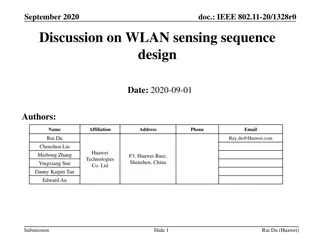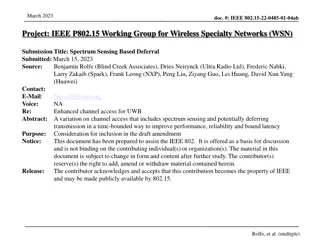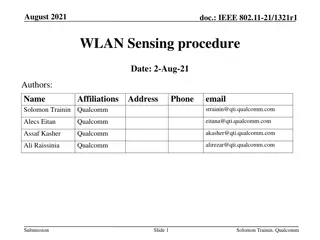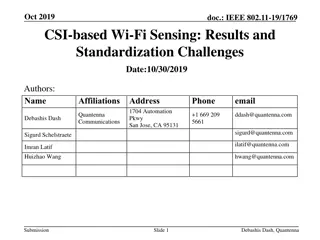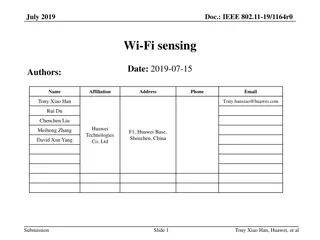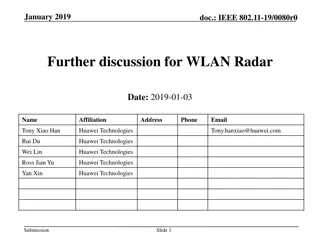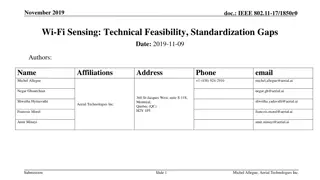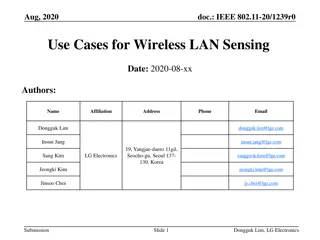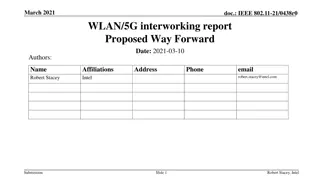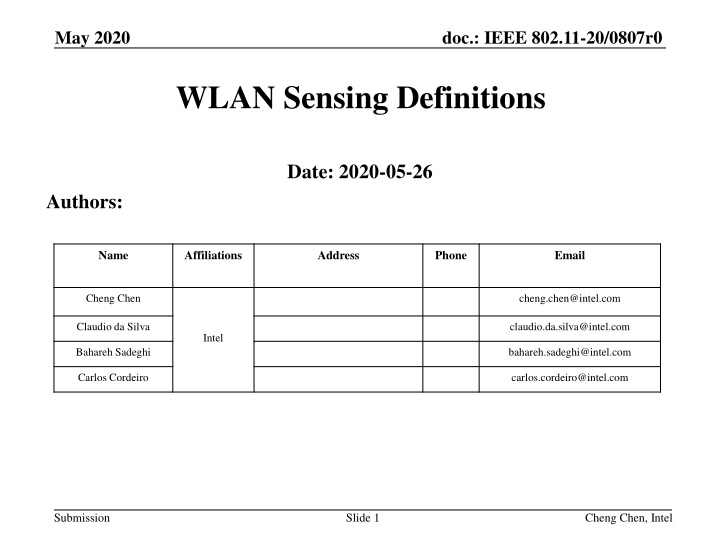
WLAN Sensing Definitions and Measurements Overview
Explore the definitions and implementations related to WLAN sensing proposed in the IEEE 802.11-20/0807r0 document. The presentation covers various aspects including background information, categories of WLAN sensing implementations, measurement procedures, and different implementations for obtaining channel measurements. Dive into the details of WLAN sensing and its applications in areas like gesture recognition, home security, and smart buildings.
Download Presentation

Please find below an Image/Link to download the presentation.
The content on the website is provided AS IS for your information and personal use only. It may not be sold, licensed, or shared on other websites without obtaining consent from the author. If you encounter any issues during the download, it is possible that the publisher has removed the file from their server.
You are allowed to download the files provided on this website for personal or commercial use, subject to the condition that they are used lawfully. All files are the property of their respective owners.
The content on the website is provided AS IS for your information and personal use only. It may not be sold, licensed, or shared on other websites without obtaining consent from the author.
E N D
Presentation Transcript
doc.: IEEE 802.11-20/0807r0 May 2020 WLAN Sensing Definitions Date: 2020-05-26 Authors: Name Affiliations Address Phone Email Cheng Chen cheng.chen@intel.com Claudio da Silva claudio.da.silva@intel.com Intel Bahareh Sadeghi bahareh.sadeghi@intel.com Carlos Cordeiro carlos.cordeiro@intel.com Submission Slide 1 Cheng Chen, Intel
doc.: IEEE 802.11-20/0807r0 May 2020 Abstract This contribution proposes definitions related to WLAN sensing that could be adopted by SENS SG/TG ). Submission Slide 2 Cheng Chen, Intel
doc.: IEEE 802.11-20/0807r0 May 2020 Background WLAN sensing implementations can be roughly divided into one of the two following categories: Same device transmits and receives a sensing PPDU Like traditional radar systems (monostatic), such as those based on FMCW. Often relies on mmWave technology and Doppler processing. Example: Gesture recognition. Sensing is performed by tracking changes on a wireless channel through the reception of multiple PPDUs over time Time-variations of the channel are usually classified into events/activities/ through signal processing and/or ML/AI. Often implemented using 2.4/5/6 GHz technology, supporting wide coverage and lower-resolution (~meter) applications. Example: Home security and smart buildings. The material that follows is mostly focused on the second category as defined above; however, it also applies in part to the first case. Submission Slide 3 Cheng Chen, Intel
doc.: IEEE 802.11-20/0807r0 May 2020 WLAN Sensing Measurements One of the main areas of focus of the WLAN Sensing amendment will be the definition of procedures that enable efficient and reliable channel measurement (or sampling ). Measurements used by WLAN sensing could be obtained: 1. By the same STA that supports WLAN sensing Often referred to as opportunistic or implicit [1] 2. Feedback sent by a different STA Referred to as explicit in [1]. Note: Each of the two approaches defined above have advantages/disadvantages, and may be required for specific use cases. This analysis is beyond the scope of this presentation, and will be considered in future contributions. Submission Slide 4 Cheng Chen, Intel
doc.: IEEE 802.11-20/0807r0 May 2020 WLAN Sensing Measurements: Implementation 1 The STA that supports WLAN sensing (STA 1 in the figure below) obtains measurements itself/directly using PPDUs transmitted by a peer STA (STA 2). PPDUs STA 1 STA 2 STA that supports WLAN sensing The PPDUs used to obtain measurements could be received, for example, during a data/management exchange (including Beacon frames) or as a result of a ping-like procedure. Submission Slide 5 Cheng Chen, Intel
doc.: IEEE 802.11-20/0807r0 May 2020 WLAN Sensing Measurements: Implementation 2 The STA that supports WLAN sensing (STA 1) uses feedback of measurements obtained by a peer STA (STA 2). Example: Beamforming sounding procedure: STA 1 transmits an NDP Announcement followed by an NDP STA 2 estimates the MIMO channel, compresses the feedback, and sends it to STA 1 NDPA + NDP STA 1 STA 2 Feedback STA that supports WLAN sensing The fact that sensing measurements may or may not be taken by the same STA that supports WLAN sensing creates confusion at times. Submission Slide 6 Cheng Chen, Intel
doc.: IEEE 802.11-20/0807r0 May 2020 Definition of sensing roles A sensing procedure allows a STA to perform WLAN sensing and obtain measurement results. A sensing session is an instance of a sensing procedure with the associated scheduling if applicable, and operational parameters of that instance. Sensing initiator and sensing responder Depends on which STA initiates a WLAN sensing session and obtains and/or requests measurements Sensing initiator: a STA that initiates a WLAN sensing session Sensing responder: a STA that participates in a WLAN sensing session initiated by a sensing initiator Sensing transmitter and sensing receiver Depends on who transmits the PPDUs used to obtain measurements Sensing transmitter: a STA that transmits PPDUs used for sensing measurements in a sensing session Sensing receiver: a STA that receives PPDUs sent by a sensing transmitter and performs sensing measurements In some scenarios, the different roles could collapse to one device. In the last two slides, STA 1 is the sensing initiator and STA 2 is the sensing responder. Case 1 Case 2 Sensing Transmissions Sensing Transmissions STA 1 STA 2 STA 1 STA 2 Sensing Receiver Sensing Transmitter Sensing Transmitter Sensing Receiver Sensing Measurement Report Submission Slide 7 Cheng Chen, Intel
doc.: IEEE 802.11-20/0807r0 May 2020 Relationship between different sensing roles Which STA requests WLAN sensing measurements? The sensing initiator. Which STA obtains measurements? The sensing receiver. During a sensing procedure, either the sensing initiator or sensing responder(s) transmits PPDUs used to obtain WLAN sensing measurements. Therefore, if the sensing initiator is also the sensing transmitter, it needs to get the measurement results from the sensing responder(s). Otherwise if the sensing initiator is the sensing receiver, there is no need to feedback measurements results. Submission Slide 8 Cheng Chen, Intel
doc.: IEEE 802.11-20/0807r0 May 2020 Multiple-device scenarios When there are multiple STAs involved in a WLAN sensing session: Sensing initiator: Should only be one device If multiple devices would like to initiate, they should be separated into different sensing procedures, instead of combined into one procedure. Sensing responder(s): Can be multiple Sensing transmitter(s): Can be multiple Sensing receiver(s): Can be multiple It is shown in [5] that TX and RX STA diversity could improve sensing performance. Slide 9 Submission Cheng Chen, Intel
doc.: IEEE 802.11-20/0807r0 May 2020 Conclusions In this contribution, we illustrated the fact that devices involved in WLAN sensing can take on different sensing roles. We proposed definitions related to the different roles a STA can assume in WLAN sensing. Submission Slide 10 Cheng Chen, Intel
doc.: IEEE 802.11-20/0807r0 May 2020 Straw Poll Do you agree with the definitions of different sensing roles as shown in Slide 7? Submission Slide 11 Cheng Chen, Intel
doc.: IEEE 802.11-20/0807r0 May 2020 References [1] 19/1769r1, "CSI-based Wi-Fi Sensing: Results and Standardization Challenges [2] Wi-Fi sensing: Usages, requirements, technical feasibility and standards gaps, IEEE 802.11-19/1293r0. [3] Wi-Fi sensing in 60GHz band, IEEE 802.11-19/1551r1. [4] Usage models for WLAN sensing, IEEE 802.11-19/1725r0. [5] Wi-Fi sensing: Cooperation and standard support, IEEE 802.11-19/1416r0. [6] 802.11 sensing: Applications, feasibility, standardization, IEEE 802.11-19/1626r1. Submission Slide 12 Cheng Chen, Intel








